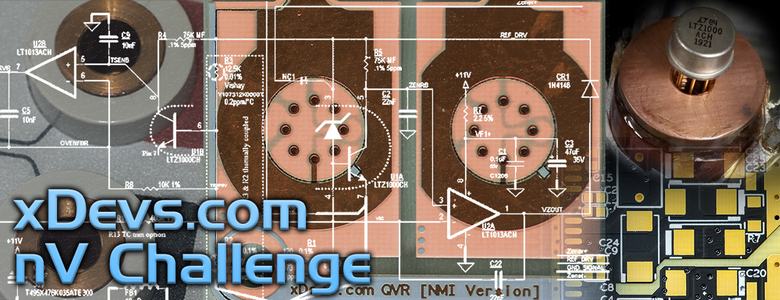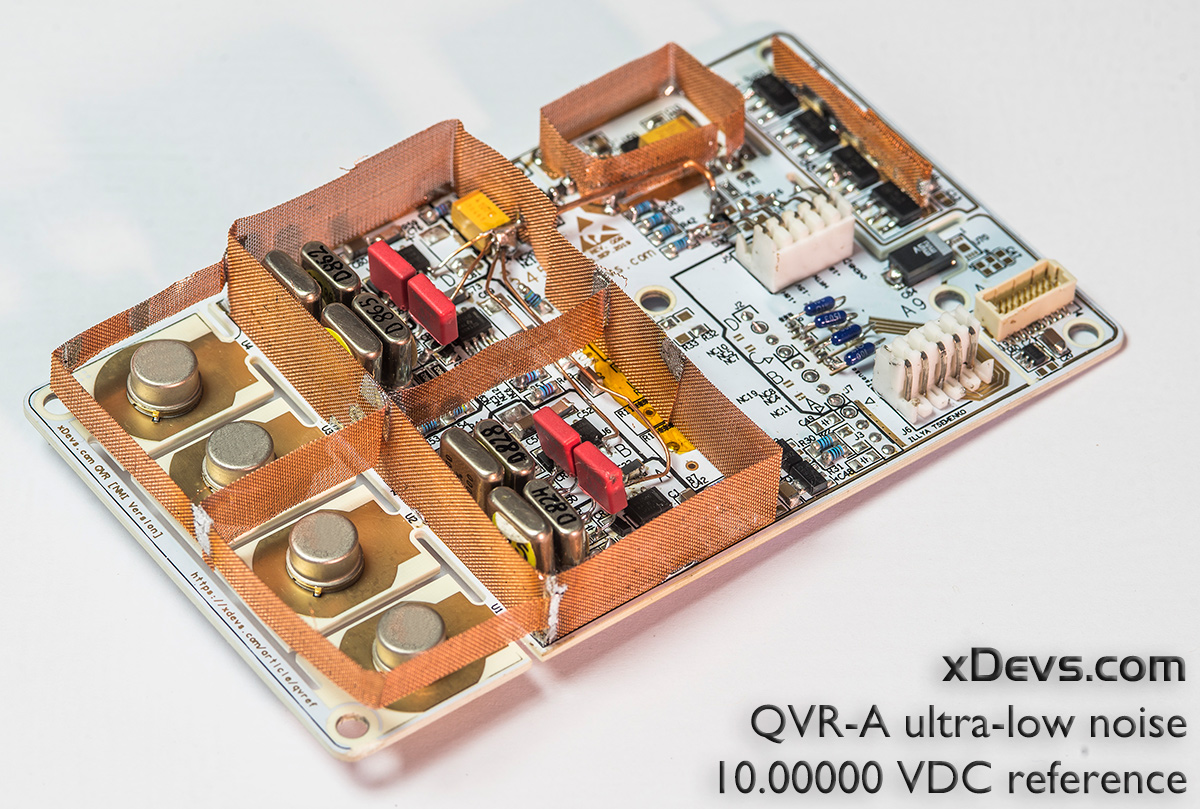
What is this Nanovolt Challenge?
Welcome to this friendly competition dedicated to building some nanovolt-grade hardware and analog designs! This public challenge dedicated for making your own open-source DC Voltage measurement device. Main audience is the electronic design engineers and metrology scientists, who have practical interests in performing very low level DC Voltage signal measurements (microvolt level and below).
Main goal of this contest is to show practical benefits of proposed nanovolt-capable design, not just theoretical possibility of such. There are many new ideas for low-level DC voltage measurements available with modern electronics and advance in digital and analog circuit designs, but very few are actually publicly discussed or demonstrated. This contest main goal is to promote such ideas and show openly what can be achieved in practical accomplished device. Publications resulted from this challenge can help to educate and provide rare knowledge for next generation engineers and scientists, helping with mankind advance.
This challenge is transparent and welcomes ongoing discussion about all and any of the submissions. Discussion can be done online at public xDevs.com IRC-chat or publicly on any online forum.
Challenge terms and rules
For international metrology community benefits it was decided that each project must comply with next conditions:
- Each submission entry must be based on actual physical design prototype and include design, measurement results and proof of operation.
- Submissions must be completed in 256 days term between September 2, 2021 23:59 EST and May 16, 2022 23:59 EST.
- All design information, including schematics, PCB files (not only Gerbers), libraries, simulation files and source code/firmware files must be publicly available under free to reuse license.
- Wiki or work log write-up about the project (at least 2000 words) with permission to publish it on xDevs.com site.
- There is no budget or component selection limit, as far as previous conditions about public design information is met.
- All designs must come with some sort of verification and performance results data. Noise, gain accuracy, thermal stability (+18 to +28 °C) and linearity parameters data is expected.
- Must not violate any commercial IP or 3rd-party license(s) (e.g. reverse-engineered commercial nano-voltmeter is not OK).
- All submissions must be written in English language.
Bonus point – if you were already working on nanovolt-related project before September 2, 2021, you can reuse any existing hardware, software or firmware and knowledge acquired, given that it should be published within submission entry and released for public as result.
Designs and entries should be uploaded to FTP-server listed below or submitted to team[@]xdevs.com email with subject title [nV-contest].
FTP credentials
- Server : ftp://xdevs.com
- Login : nvc_contest
- Password : nvc_entry
Submissions should be done by uploading single ZIP-archive file with all relevant project design, measurement and work log data.
Multiple submissions or corrections for earlier submitted entry are welcome and accepted until the time deadline May 16, 2022 23:59 EST.
Criteria for project relevance for acceptance
Proposed design must include hardware and software/firmware related to functionality of the unit. Additional calibration and used testing fixtures information is not required but very welcome. To focus design around somewhat common goal each of the nanovolt device entry should be able to perform next functionality to be accepted:
- Have local onboard power regulation. Single common DC (+9 to +24 VDC) or 110/220VAC mains input jack is expected.
- Provide DC Voltage measurement ranges ±100 µV or below and include ±1V and ±10VDC range.
- Have at least two user-accessible input channels for signal to be measured.
- Have low-thermal connection interface to minimize thermal EMF parasitic errors.
- Provide at least 5½-digit resolution for each reading.
- Ability to digitize input DC signal with resolution at least 10 nV and noise better than 30 nV peak to peak over at least 0.1-10 Hz bandwidth.
- Have autozero functionality to correct for static offsets.
- Have galvanic isolated analog front end, with isolation resistance to earth/chassis better than 10 GΩ.
- Device should have ADC (any type) integrated.
- Have good long-term stability and use ovenized DC voltage reference (LM399, LTZ1000 or LTFLU with oven).
- Provide RJ45 Ethernet and/or IEEE-488 GPIB interface for communications with external world / external equipment.
- 40W total input power budget (friendly to battery operation for sensitive experiments)
- Device should be fully operational as standalone device (e.g. no debuggers or external equipment attached to make it work).
Everything else is up to designers, no other limitations or restrictions. References with voodoo-slots, multi-layer PCBs, fancy OLED displays, Raspberry Pi controllers, gold-plated Titanium enclosures – all is welcome.
Scoring the projects and jury
Each project will be carefully evaluated and ranked by next four key parameters:
- Measurement performance (noise, stability, available bandwidth and thermal stability) – 50 points out of 100 maximum
- User friendly experience (ease of use and configuration, available controls, provided documentation) – 20 points out of 100 maximum
- Programmable functionality (calibration, adjustment, modes and features, automation, protocol) – 20 points out of 100 maximum
- Cost and manufacturing (cost and components selection, assembly quality and repairability) – 10 points out of 100 maximum
Project that reaches maximum amount of points will be nominated as the ultimate winner.
Compensation for winning project
Since reaching goals of the project are not easy nor simple additional motivation is provided for the best design award.
- Special version of xDevs.com QVR-A module with four of brand new Analog Devices ADR1000 ultra-low noise references.

Unique quad-zener 10.00000 VDC reference on 6-layer ceramic PCB
Reference will be packaged in custom rugged aluminum enclosure with low-thermal connectors and protected in hard-case shipping container.
Shipping cost of the QVR-A and calibration will be covered by xDevs.com. Projects will be judged and carefully reviewed after challenge reach the deadline cutout. Final results and ranking will be provided on this page no later than June 16, 2022 23:59 EST. Reference and calibration will be shipped to winner no later than July 31, 2022.
Additional items and prizes might be added in future.
Disclaimer and warnings
Redistribution and use of this materials provided during and after this challenge, any parts or any images or files referenced in it, in source and binary forms, with or without modification, are permitted provided that the following conditions are met:
- Redistributions of the project must retain the above copyright notice, this list of conditions, link to this page (https://xdevs.com/article/nvm_comp/) and the following disclaimer.
- Redistributions of files in binary form must reproduce the above copyright notice, this list of conditions, link to this page (https://xdevs.com/article/nvm_comp/), and the following disclaimer in the documentation and/or other materials provided with the distribution, for example, Readme file.
All information posted here is hosted just for education purposes and provided AS IS. In no event shall the author, xDevs.com site, project author or any other 3rd party be liable for any special, direct, indirect, or consequential damages or any damages whatsoever resulting from loss of use, data or profits, whether in an action of contract, negligence or other tortuous action, arising out of or in connection with the use or quality of information published here.
Eligibility
Contestants may be individuals or team of individuals, if their project meets all other requirements listed on this page.
Contestants must own or have access at their own expense to a computer, an Internet connection, and any other electronic devices, documentation, software, or other items that they may deem necessary to create, build and test submission project.
Contestants are NOT required to ship or provide any hardware they built for this challenge contest. xDevs.com or any 3rd party does not need to have it to accept participation in this event.
No individual or team may enter this challenge on behalf of a corporation or other non-individual legal entity.
Individuals must be over the age of 18 at the time of submission and have qualifications to safely operate and build electronic devices.
This challenge organizer reserves the right to deny acceptance or project submission without providing reason. (but hope it does not come to this point)
Pending members with submitted projects
Accepted and confirmed projects and submissions
Below is the list of project submissions that are currently accepted.
| Project author | Project name | Design repository | Measured noise and bandwidth | Measured gain | Measured TC | Measured linearity |
|---|---|---|---|---|---|---|
| jaromir | nvm | GitHub , EEVBlog | 25 nVpk-pk, 0.1-10 Hz | TBD | <25 nV/°C | ±0.4 ppm (range ?) |
Summary and conclusion
This challenge is completed. Only one submission is received from jaromir , so there was no much choice for winner :-).
Difficult situation with components availability and overall situation in the world makes it hard to participate in such projects, so I’m quite happy that we got even one submission here.
Hopefully in future when industry recovers we would be able to make more interesting public challenges for ppm metrology and engineering community.
Projects like this are born from passion and a desire to share how things work. Education is the foundation of a healthy society - especially important in today's volatile world. xDevs began as a personal project notepad in Kherson, Ukraine back in 2008 and has grown with support of passionate readers just like you. There are no (and never will be) any ads, sponsors or shareholders behind xDevs.com, just a commitment to inspire and help learning. If you are in a position to help others like us, please consider supporting xDevs.com’s home-country Ukraine in its defense of freedom to speak, freedom to live in peace and freedom to choose their way. You can use official site to support Ukraine – United24 or Help99. Every cent counts.
Modified: Oct. 25, 2022, 6:43 a.m.

